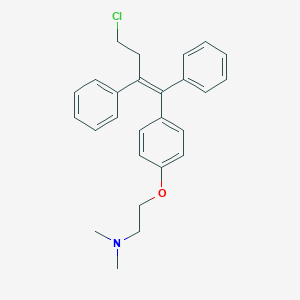Estrogen receptor positive metastatic breast cancer in postmenopausal women, Estrogen receptor unknown metastatic breast cancer in postmenopausal women
Adult: 60 mg once daily, continued until disease progression occurs.
|
Chỉ định và Liều dùng
Oral
Estrogen receptor positive metastatic breast cancer in postmenopausal women, Estrogen receptor unknown metastatic breast cancer in postmenopausal women Adult: 60 mg once daily, continued until disease progression occurs.
|
|
Nhóm bệnh nhân đặc biệt
Patient taking enzyme inducing drugs (e.g. phenobarbital, carbamazepine): Dose adjustment may be necessary.
|
|
Suy gan
Severe: Contraindicated.
|
|
Cách dùng
May be taken with or without food.
|
|
Chống chỉ định
Pre-existing endometrial hyperplasia, congenital or documented acquired QT prolongation, electrolyte disturbance (e.g. uncorrected hypokalaemia or hypomagnesaemia), clinically relevant heart failure with reduced LVEF, clinically significant bradycardia, history of symptomatic arrhythmias or severe thromboembolic disease. Severe hepatic impairment. Concomitant use with other drugs that prolong QT interval.
|
|
Thận trọng
Patient with diabetes mellitus, hypertension, high BMI (>30), history of HRT, acute myocardial ischaemia, non-compensated cardiac insufficiency, severe angina pectoris, bone metastasis. Patient taking enzyme inducing drugs. Avoid concomitant use with strong CYP3A4 inhibitors and coumarin anticoagulants. Not recommended in patients with estrogen receptor negative tumours. Mild to moderate hepatic impairment. Elderly. Pregnancy and lactation.
|
|
Tác dụng không mong muốn
Significant: Anaemia, thrombocytopenia, leucopenia, hepatotoxicity (e.g. elevated transaminases, hepatitis, jaundice); tumour flare and hypercalcaemia (in patients with bone metastases); uterine malignancy (e.g. endometrial cancer, hyperplasia, hypertrophy, uterine polyps); pulmonary embolism, MI, ischaemic attack, thrombophlebitis.
Eye disorders: Cataracts, dry eyes, corneal keratopathy, glaucoma, abnormal visual fields, abnormal vision. Gastrointestinal disorders: Nausea, vomiting. General disorders and administration site conditions: Fatigue, oedema. Nervous system disorders: Dizziness. Psychiatric disorders: Depression. Reproductive system and breast disorders: Leucorrhoea, uterine bleeding. Skin and subcutaneous tissue disorders: Hyperhidrosis, itching, rash. Vascular disorders: Hot flushes. Potentially Fatal: Prolonged QTc interval (dose-related) which may lead to torsades de pointes, syncope or seizure. |
|
Chỉ số theo dõi
Perform gynaecological examination prior to treatment initiation and annually, thereafter. Monitor CBC with differential and LFT periodically; electrolytes (Mg and K at baseline and periodically during therapy; Ca periodically). Obtain ECG at baseline and periodically during treatment (in patients at risk of QT prolongation). Closely monitor for hypercalcaemia in patients with bone metastases during the 1st few weeks of therapy. Assess for signs or symptoms of uterine disorders (e.g. bleeding, discharge, pelvic pain or pressure); thromboembolism, MI, oedema, and vision changes.
|
|
Quá liều
Symptoms: Dizziness, headache, vertigo. Management: Symptomatic treatment.
|
|
Tương tác
May increase the risk of hypercalcaemia with drugs that decrease renal calcium excretion (e.g. thiazide diuretics). Concomitant use with coumarin anticoagulants (e.g. warfarin) may result in a significantly increased bleeding time. Steady-state concentration in serum may be increased with strong CYP3A4 inhibitors (e.g. atazanavir, ritonavir, clarithromycin, itraconazole, ketoconazole, nefazodone). May increase the rate of metabolism with enzyme inducers (e.g. phenobarbital, carbamazepine, phenytoin).
Potentially Fatal: May result in additive effect on QT interval prolongation when used concomitantly with other drugs that may prolong the QTc interval such as antiarrhythmic class IA (e.g. disopyramide, quinidine, procainamide) or class III (e.g. ibutilide, amiodarone, dofetilide, sotalol), certain antimicrobial drugs (e.g. moxifloxacin, pentamidine, IV erythromycin, halofantrine), certain antihistamines (terfenadine, astemizole, mizolastine), neuroleptics (e.g. haloperidol, phenothiazines, pimozide, sertindole, sultopride), certain antidepressants (e.g. amitriptyline, venlafaxine), certain antiemetic drugs (e.g. granisetron, ondansetron), cisapride, bepridil, IV vincamine, and diphemanil. |
|
Tương tác với thức ăn
May increase serum concentrations with grapefruit juice; avoid concomitant use.
|
|
Tác dụng
Description:
Mechanism of Action: Toremifene is a nonsteroidal triphenylethylene derivative that has strong antiestrogenic properties and estrogenic effects (influenced by several factors). It competitively binds to estrogen receptors on tumours and inhibits estrogen-induced stimulation of DNA synthesis and cell replication. Pharmacokinetics: Absorption: Well absorbed from the gastrointestinal tract. Time to peak plasma concentration: Within 3 hours (range: 2-5 hours). Distribution: Volume of distribution: 580 L. Plasma protein binding: >99.5%, predominantly to albumin. Metabolism: Extensively metabolised in the liver by CYP3A4 via N-demethylation to form N-demethyltoremifene (main metabolite; weak antiestrogen). Undergoes enterohepatic circulation. Excretion: Mainly via faeces (as metabolites); urine (approx 10% as metabolites). Elimination half-life: Toremifene: Approx 5 days; approx 7 days (females >60 years). N-demethyltoremifene: 6 days. |
|
Đặc tính
 Source: National Center for Biotechnology Information. PubChem Compound Summary for CID 3005573, Toremifene. https://pubchem.ncbi.nlm.nih.gov/compound/Toremifene. Accessed June 25, 2021. |
|
Bảo quản
Store at 25°C. Protect from light and heat. Follow applicable procedures for receiving, handling, administration, and disposal.
|
|
Phân loại MIMS
|
|
Phân loại ATC
L02BA02 - toremifene ; Belongs to the class of anti-estrogens. Used in treatment of neoplastic diseases.
|
|
Tài liệu tham khảo
Anon. Toremifene. AHFS Clinical Drug Information [online]. Bethesda, MD. American Society of Health-System Pharmacists, Inc. https://www.ahfscdi.com. Accessed 10/05/2021. Anon. Toremifene. Lexicomp Online. Hudson, Ohio. Wolters Kluwer Clinical Drug Information, Inc. https://online.lexi.com. Accessed 07/05/2021. Buckingham R (ed). Toremifene Citrate. Martindale: The Complete Drug Reference [online]. London. Pharmaceutical Press. https://www.medicinescomplete.com. Accessed 07/05/2021. Fareston 60 mg Tablets (Orion Corporation). European Medicines Agency [online]. Accessed 07/05/2021. Fareston Tablet (Kyowa Kirin, Inc). DailyMed. Source: U.S. National Library of Medicine. https://dailymed.nlm.nih.gov/dailymed. Accessed 07/05/2021. Joint Formulary Committee. Toremifene. British National Formulary [online]. London. BMJ Group and Pharmaceutical Press. https://www.medicinescomplete.com. Accessed 07/05/2021.
|